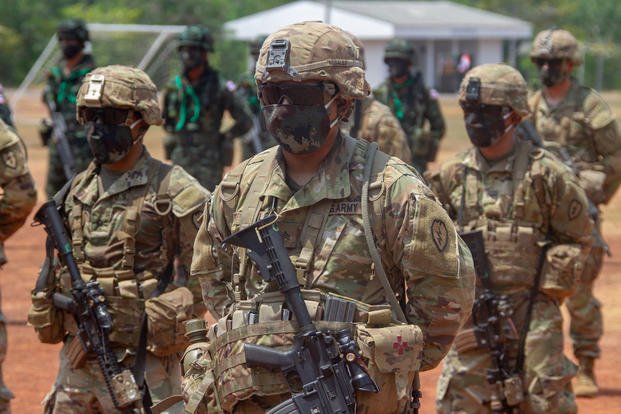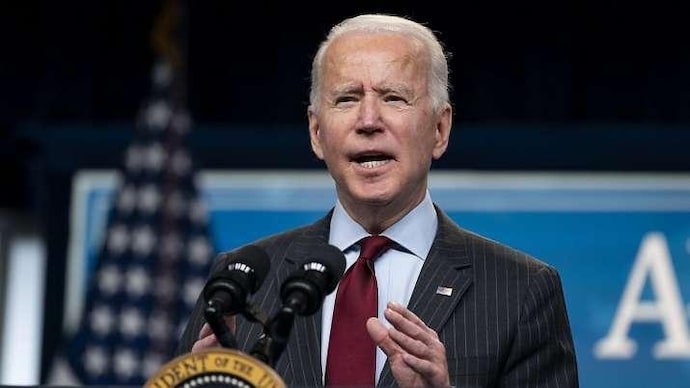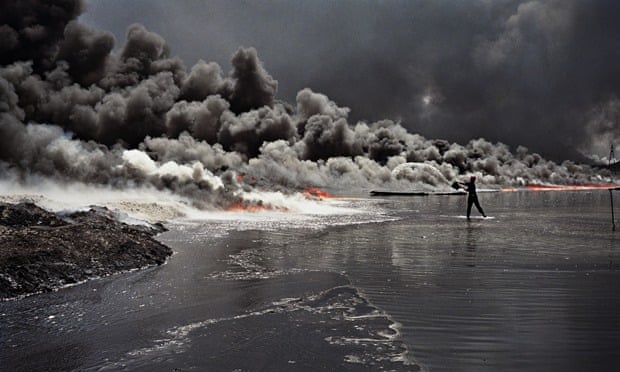US Fighter Jets Scrabbled, Strike Syria After Attacks By Iran-Backed Militia; With Geopolitical Tensions Escalating At Key Regions Are We Invariably Heading For World War III
US President Joe Biden is leaving no stone unturned as he delivers a strong message to several critical escalations that the world is witnessing currently. After mincing no words and delivering a strong message to China over Philippines Ships in the South China Sea, yesterday he ordered strikes by U.S. fighter jets in Syria in response to attacks on U.S. forces by Iranian-backed militia. Even as the Russia-Ukraine war sees no cessation, the heightened tensions following the Isreal Hamas conflict, the world has never inched closer than right now towards World War III, and the implications will be far more devastating than ever before.

US President Joe Biden ordered strikes on the two facilities used by Iran’s Revolutionary Guard Corps and militia it backs.
Two U.S. fighter jets struck weapons and ammunition facilities in Syria on Friday in retaliation for attacks on U.S. forces by Iranian-backed militia as concerns grew that the Israel-Hamas conflict may spread in the Middle East.
The Pentagon issued a strong warning that the U.S. will take additional measures if attacks by Iran’s proxies continue; U.S. and coalition troops have been attacked at least 19 times in Iraq and Syria by Iran-backed forces in the past week. Hamas, Islamic Jihad and Lebanon’s Hezbollah are all backed by Tehran.
Earlier, Iranian Foreign Minister Hossein Amirabdollahian said at the United Nations on Thursday that if Israel’s offensive against Hamas did not stop, the United States will “not be spared from this fire”.
The U.S. air strikes took place at roughly 4:30 a.m. on Friday in Syria (0130 GMT) near Abu Kamal, a Syrian town on the border with Iraq, and were carried out by two F-16 fighter jets using precision munitions, a U.S. defence official said.
“These precision self-defence strikes are a response to a series of ongoing and mostly unsuccessful attacks against U.S. personnel in Iraq and Syria by Iranian-backed militia groups that began on October 17,” U.S. Defense Secretary Lloyd Austin said in a statement.
“These Iranian-backed attacks against U.S. forces are unacceptable and must stop,” Austin said.
On Thursday, The White House said that Biden sent a rare and unequivocal message to Iranian Supreme Leader Ayatollah Ali Khamenei, warning Tehran against targeting U.S. personnel in the Middle East.
“What we want is for Iran to take very specific actions, to direct its militias and proxies to stand down,” a senior U.S. defence official said. The United States did not coordinate the air strikes with Israel, the official added.

Meanwhile, Israel said on Friday that the military was preparing raids into Gaza, “the next stage of the operation,” amid fears that a ground invasion of the Palestinian enclave could spark a wider Middle East conflict.
Israel has bombarded the densely populated Gaza Strip following the October 7 Hamas attack on Israeli communities where, according to Israel, Hamas killed some 1,400 people including children, and took more than 200 hostages, some of them infants and older adults.
On Thursday, the Hamas-controlled Gaza health ministry said 7,028 Palestinians had been killed in the retaliatory air strikes, including 2,913 children.
Egypt’s Al Qahera News reported a missile launched as part of the fighting between Hamas and Israel struck an Egyptian resort town about 220 km (135 miles) from the Gaza Strip early on Friday.
The missile hit a medical facility in Taba, injuring at least six people, Al Qahera TV reported; a witness in Taba confirmed hearing an explosion and seeing smoke rising; Taba straddles Egypt’s border with Israel’s Red Sea port of Eilat. Meanwhile, Israel’s military said it was aware of a security incident outside its borders.

U.S. Sends In More Troops
Governments in the West and the Middle East are growing concerned about a wider regional conflict developing if Israel continues its bombardment of Gaza or mounts a ground invasion in response to the surprise attack by Hamas.
Israel and Lebanon-based Hezbollah have already exchanged fire, and Israel has targeted Syrian army infrastructure and airports.
The United States has continued to send warships and fighter aircraft to the region over the last three weeks, and on Thursday, the Pentagon revealed that about 900 more U.S. troops have arrived in the Middle East or are heading there to bolster air defences for U.S. personnel.
For Israel’s part, Defence Minister Yoav Gallant, asked at a press conference about the possibility of a confrontation with Iran, said Israel has “no interest in expanding the war.”

United States Spread Thin On Many Fronts
Earlier, President Joe Biden warned China and stated its commitment to defending the Philippines in the event of an attack in the disputed South China Sea.
This statement closely follows two recent collisions involving Filipino and Chinese vessels within the contested waters.
President Biden emphasized the “ironclad” nature of the United States’ defence commitment to the Philippines, which has been challenging China’s claims to these waters.
Biden’s statement, issued on Wednesday, represents the most forceful stance taken by the United States regarding the tensions between Beijing and Manila that have intensified in recent months.
The President underlined the 1951 Mutual Defense Treaty, binding the U.S. and its former colony, the Philippines, to mutual defence in the event of an armed attack.
He explicitly stated, “Any attack on Filipino aircraft, vessels, or armed forces will invoke our Mutual Defense Treaty with the Philippines.”
These remarks were delivered at the White House during a meeting with Australian Prime Minister Anthony Albanese.
)
Both of these incidents occurred within the Philippines’ Exclusive Economic Zone (EEZ) and were related to reinforcing the Philippines’ territorial claims.
The Philippines holds strategic importance for the United States, as it shares borders with two potential flashpoints in the Pacific – the South China Sea and Taiwan.
The Viewpoint
The world today finds itself in a precarious position, where the notion of a third world war looms as a dark cloud on the horizon, and while it is essential to remain cautious and perhaps optimistic yet, the signs are increasingly alarming, suggesting that the world is dangerously inching toward World War III.
If it were to occur, the war would be significantly different from its predecessors in several critical ways.
Firstly, the nature of warfare has evolved dramatically since the last world war and the advancement of technology, particularly in the realms of cyber warfare and artificial intelligence, has the potential to reshape the battlefield in unprecedented ways, something that we have not seen before.
Unlike the conventional wars of the 20th century, World War III might see battles unfolding in virtual domains, with nations vying for control not just of physical territories but also of the digital realm.
In the wake of World War II, the United Nations was established, and international trade agreements were formed to promote cooperation and avoid further global conflicts.

Today, the global supply chain is interwoven to such an extent that a large-scale war could disrupt not only the exchange of goods but also the complexities of diplomatic relationships and economic dependencies that have been established over decades.
The economic fallout from a third world war could be, to say the least be, catastrophic, pushing countries into recession and potentially causing unprecedented worldwide economic strife.
Nuclear weapons, a defining feature of the Cold War era, remain a critical factor in discussions about a potential World War III even as firearms have become more sophisticated, as seen in the Isreal Hamas Conflict.
The possession of nuclear arsenals by multiple nations poses a terrifying scenario, as any conflict escalation could lead to the use of these devastating weapons.
The consequences of a nuclear exchange in the modern era are even more harrowing, with advancements in nuclear technology allowing for more precise targeting and potentially lower yields.

A limited nuclear exchange could still result in catastrophic casualties and long-lasting environmental damage, one that we may not be able to overcome.
Unlike previous world wars, the lines between allies and adversaries are no longer as clearly defined. In today’s globalized world, countries maintain complex, multifaceted relationships.
Traditional alliances, such as NATO and the European Union, have been called into question, while new partnerships are forming in response to shifting global dynamics.
The role of non-state actors, including powerful multinational corporations, is increasingly influential, further complicating the global political landscape.
In a World War III scenario, the array of alliances and adversaries could be ever-shifting, making it challenging to predict the course of the conflict and the allegiances that may emerge.
Perhaps one of the most significant differences in the prospect of World War III is the potential for unconventional warfare.
As nations grapple with the consequences of a large-scale conflict, strategies that involve misinformation, disinformation, and propaganda could play a pivotal role in shaping public opinion and sowing discord within enemy ranks.

The digital age has given rise to a new battleground where public sentiment and perception can be manipulated on a massive scale; cyberattacks and psychological operations may be used to target not only military infrastructure but also the hearts and minds of a nation’s citizens.
Similarly, as mentioned before, the consequences of a third world war extend beyond the battlefield and into the environment, and the impact on the planet’s ecosystems, resources, and climate could be profound.
With the potential for widespread destruction and the use of powerful, environmentally damaging weaponry, World War III could deepen existing environmental crises and create new ones.
The quest for scarce resources, such as water and arable land, may become a driving factor in the conflict, leading to resource wars that further strain the planet’s ability to sustain human life.
The Last Bit,
The world is undeniably facing a precarious future, with the ominous specter of World War III looming on the horizon.
If such a conflict were to occur, it would be vastly different from its predecessors, marked by the use of advanced technology, economic interdependence, the ghost of nuclear annihilation, complex and shifting alliances, unconventional warfare, and profound environmental consequences.
As a global community, it is imperative that we remain committed to diplomatic efforts, conflict resolution, and cooperation to prevent the catastrophic outcome of another world war.
The lessons of history should guide us toward a future where peace and cooperation prevail over the devastation of global conflict.




